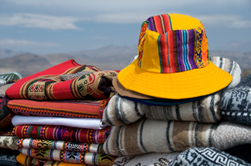Humans have inhabited the Andean region as far back as 15,000
BC. The first humans were believed to migrate to these great mountains for the
security they offered. However, the new region imposed an entirely new environmental
stress: high altitude. In high altitudes, the oxygen level is lower and
dispersed, causing lower pressure than the low-lands surrounding it. With less
oxygen in the air, humans would inhale less oxygen particles into the lungs,
allowing a limited supply to be absorbed by the red blood cells. In result, the
red blood cells cannot carry and supply sufficient oxygen to vital organs
causing hypoxia. This greatly impacts
the survival of humans in that oxygen is extremely vital to keep our bodies
working properly.
Luckily, humans are extremely adaptive in that we are a
diverse species. Humans have adapted to this environmental stress through short
term, facultative, developmental, and cultural types of adaptations. Imagine
you plan a trip to the Andes to learn about the Quichia, the largest of any indigenous
peoples in the Americas. As you elevate,
the atmosphere becomes lighter, your pulse rate and blood pressure go up
causing stressful, but effective changes. This particular adaptation is only
beneficial if you’re only visiting.
This is where a facultative adaptation
would come in. If after your visit to the mountains you decide that you’re
better off moving there, your body will turn on and off genes to alter a
phenotypic expression in response to the stress without altering your DNA. This
means the amount of oxygen your blood cells carry will increase whenever you
experience a reduction in atmospheric pressure.
After your visit, you fall in love with the people and
lifestyle of the culture, so you decide to stay. You marry a nice Quichian and have a child.
These particular peoples have developed an increase in lung capacity and an
increased chest size allowing an increase in pulmonary diffusion capacity. This
developmental trait is a change in the DNA of the population and is called developmental
adaptation. Although you lack this trait, your partner has passed it on to your
child, thus giving them the advantage of survival in high altitudes.
Now, you’re learning that not only do you have to cope with
the low atmospheric pressure, but you have to deal with extreme weather
conditions. To keep warm in the freezing winter, the Quichian give you colorful
garments made of Alpaca wool. Potatoes are freeze-dried by a special technique
to preserve for the rest of the year and prepared in hot stews.
Studying human variation from this perspective across environmental
clines is extremely beneficial in that we can understand how humans adapt to
diverse environments. In better understanding
that adaptation to high latitudes is a gradual process, mountain climbing
illnesses can be prevented. If one understands that if given the right amount of
time, your body will endure a facultative adaptation giving you better oxygen
supply and endurance. Another example
would be skin color. In response to high levels of solar radiation, specialized
cells called melanocytes will produce a pigment called melanin to reflect the
radiation. Humans in regions where there is a high level of solar radiation are
darker in skin color, giving them an advantage. If scientists can develop a
product that can mimic this process it can protect many people from skin
cancer.
If I were to use “race” to help understand the variation of
the adaptations I spoke about earlier, I would declare that the skin color,
nose, and head size of the people of the Andes are all reasons to adaptation in
the region. However, people of another “race” living in similar regions do not have
the same skin color, nose, or head size. Therefore it is more beneficial to
understand the environmental influences on adaptation to understand human
variation rather than “race”.
Sources:
http://jeb.biologists.org/content/204/18/3151.full.pdf
http://www.academia.edu/1242438/Bolivian_Andes_from_climate_change_to_human_displacements_
http://www.peoplesoftheworld.org/text?people=Quichua
Sources:
http://jeb.biologists.org/content/204/18/3151.full.pdf
http://www.academia.edu/1242438/Bolivian_Andes_from_climate_change_to_human_displacements_
http://www.peoplesoftheworld.org/text?people=Quichua



